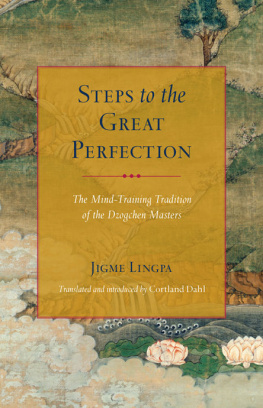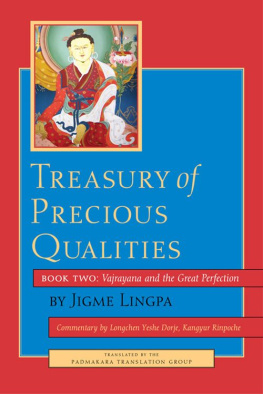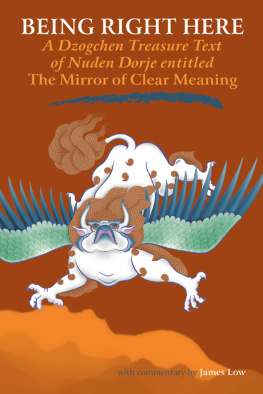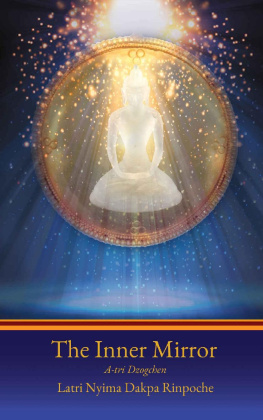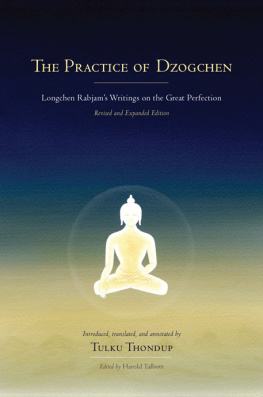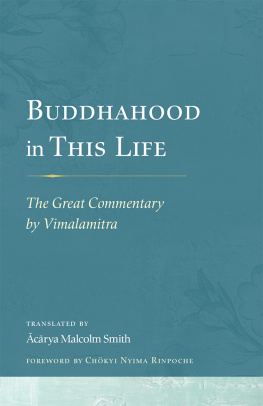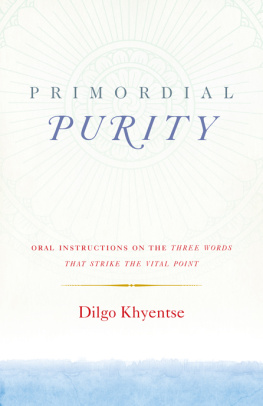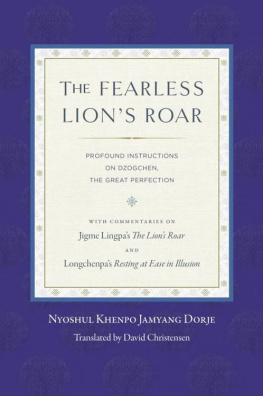THE
YESHE LAMA
Jigme Lingpas Dzogchen Atiyoga Manual
A Radical Dzogchen Translation
by Keith Dowman
Dzogchen Now! Books
Published by Dzogchen Now! Books
www.keithdowman.net
Keith Dowman 2014
All rights reserved. No part of this book may be reproduced in any form or by any means, electronic or mechanical, including photography, recording, or by any information storage or retrieval system or technologies now known or later developed without permission in writing from the publisher.
ISBN-13: 978-1502716224
ISBN-10:1502716224
Cover design by Martin Cufre
Font set in Book Antigua
Page of Boundless Restriction
The view presented in the following pages is unlimited, boundless and universal. It can only bring benefit to human beings but some require protection. In order to optimize the benefit, please observe the following precepts.
For Vajrayana Dharma Practitioners: If you are committed either formally or informally to a graduated Dzogchen path, please do not read this text without the recommendation of your mentor. A good precept to follow is, Dont read it unless you are about to practice it.
For Academics: Intellectual discussion of this material is antithetical and counterproductive to its stated end. Please be aware that analytical and comparative study of it is anathema hostility will be engendered.
For Dzogchen Chatterers: Know that talking or writing about Dzogchen on the web to similarly intellectually or socially motivated people who attempt to know it intellectually rather than existentially, dilutes or corrupts it and acts as a slow poison.
For the Curious: If you find this text in book form it would be wise to wrap it up and place it in an inaccessible place above the level of your head and remember it as the magical efflorescence of the heart. If you have it in digital form, delete it with a prayer: OM AH HUNG.
Please do not reproduce this text in any way, distribute it or pass it on, and by so doing infringe the moral copyright.
Contents
In celebration of two heart-sons of Jedrung Tinle Jampa Jungne, emanations of Padma Jungne, tertons and bodhisattvas, unborn and undying, in great compassion, Kanjur Rinpoche Longchen Yeshe Dorje and Dudjom Rinpoche Jigtral Yeshe Dorje.
Dedicated to Isla, Xavi, Zaki, Seb and Arlo
and all of their generation.
At the end of the kaliyuga, Dzogchen will burgeon and flourish while the lower vehicles will wane.
A prophecy of Guru Rinpoche.
Introduction
Here is the great Yeshe Lama, the most renowned, comprehensive and the most efficacious of the Dzogchen manuals. It is a primary sourcebook of Breakthrough/Leapover precepts. When Dzogchen was new to me, the Yeshe Lama was introduced as equivalent to the Great Perfection itself. Its name was spoken in a whisper, like the names of the most renowned lamas of the lineage. If the basic training in Vajrayana was to be arduous, the incomparable prize was the Yeshe Lama. The mere sight of this book could evoke initiatory experience and its mantric title was enough to remove any obstacle or to exorcise any devious spirit. Placed on the head, its blessing power was equal to the root lamas blessing of empowerment. Presented with an old blockprint copy by the lama, it could only be a sign of his special favor and of his confidence in his heart-son. It was the carrot held out as an incentive even before receiving basic Dzogchen instruction.
Certainly, the Yeshe Lama lives up to its reputation. It is still the crown jewel of the latter-day Dzogchen lineages. It is at the apex of the Longchen Nyingtik corpus of literature, presenting the essential Dzogchen yogas in pith instruction. The Longchen Nyingtik is based firmly on Longchen Rabjampas vision, a massive, vast and profound, Dzogchen experience written down as the Seven Treasuries, which in turn were based intimately upon the tantras of the Nyingma Gyubum, the literary treasure house of Dzogchen. Rigzin Jigme Lingpa, the mystic-scholar who composed the Longchen Nyingtik, was an incarnation of Longchenpa in the most pertinent sense of the word. He wrote it down during a time of persecution of his lineage, at a low point in the history of the lineage, but his Longchen Nyingtik became the seed, root and branch of a Dzogchen revival that reverberates around the entire world at the beginning of the twenty-first century.
That yellowed, well-thumbed blockprint copy of the Yeshe Lama, has stayed in its silk wrapping for decades, but now that need has generated the temerity to translate it, its significance to the lineage and its profound meaning in the Dzogchen tradition causes hesitation. What tips the balance, however, is the sense that at this juncture of the transmission of the Tibetan nondual tradition to the West, its future as a instrument for good depends upon a deconstruction and reformation of the old forms and a resurgence similar in depth and intensity to the Dzogchen renaissance that Jigme Lingpa initiated three hundred years ago in Tibet. Such a reformation surely depends upon embodiment of the Dzogchen view, meditation and conduct by indigenous westerners who have absorbed the transmission, assimilated it and can express it in modes, verbal and nonverbal, appropriate to their culture, and, also, sadly, relevant to contemporary fashion. This translation of the Yeshe Lama, made available to anyone who has the good fortune to come across it is like a conduit from the old dispensation to the new, a precious relic of old Tibet contributing to the dynamic awareness of the new. A reconsideration of the traditional parameters of transmission that became ossified on the Tibetan plateau through hundreds of years of conservative praxis may also benefit the younger generation of Tibetans both in Tibet and in exile.
In this radical view, the conservation and preservation of the secrets of the Yeshe Lama for a later generation take second place to providing easy access to it right now. Besides those on a traditional graduated path, also included are people emerging from Vajrayana into radical Dzogchen, people who have never had Vajrayana initiation and people who have had commitment and dedication to Dzogchen for much of their lives, and who are now preparing to die and can benefit from Jigme Lingpas vision. Equally, it may benefit younger people who have a strong intuition that Dzogchen and the Yeshe Lama somehow quintessentialize the ground of the New Age ethos. It should be clear at the beginning, however, that the Dzogchen of the traditionalist lamas who teach it as a goal at the end of the path of the Sacred Word tradition of the Vajrayana, a laddered path that includes strenuous training in the religious culture of Buddhist Tibet, is not the Dzogchen that is disclosed and discussed in this introduction. This Dzogchen is a genuine existential realization in the here and now that transcends all religion, including Buddhism and Bon, Islam and Christianity. It is what has become known as radical Dzogchen.
Radical Dzogchen, in its primary sense, implies a total commitment to the broad, unstructured, nondogmatic praxis of the Great Perfection in the now. Such broad praxis takes the individuals karmic patterning, genetically originated and then modified by behavioral conditioning, as the starting point, and then through recognition of the nature of our being utilizing its nonaction as the overarching precept informing our momentary experience. Embodying that precept we remain relaxed in our authentic nature. The imperative here is an involuntary recognition of the ineluctable immanence of the Great Perfection. The starting point is thus known as an unlimited altruistic spontaneity.
Secondly, radical Dzogchen implies a return to the roots of Dzogchen in the form of the iconic atiyoga tantras of the
Next page

